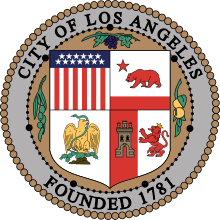Historic Filipinotown, Los Angeles
Historic Filipinotown is a district of the city of Los Angeles, California, making up the southwest portion of Echo Park. The district is bounded by Hoover Street on the west to Glendale Boulevard on the east, the US 101 Freeway on the north and Beverly Boulevard on the south. Temple Street is the neighborhood's main thoroughfare. This section of Echo Park was separated from its northern portion by the US 101 Freeway in the 1950s and the southern section of the park where the tennis courts and baseball field are located. Originally the area known as Little Manila, Historic Filipinotown was one of the first areas to be cultivated by Filipino immigrants during the early part of the 20th century. The enclave was created through a resolution proposed by council member Eric Garcetti on August 2, 2002.
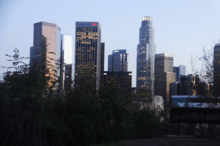
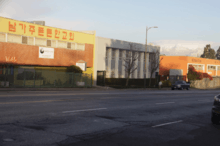
Historic Filipinotown | |
|---|---|
Neighborhood of Los Angeles | |
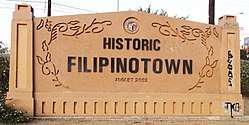 Historic Filipinotown western gateway that is located off the 101 freeway on the corner of Temple Street and Silverlake Boulevard. | |
| Nickname(s): Hi-Fi | |
| Coordinates: 34.0719°N 118.272959°W | |
| Named | 2002 |
| Zip code | 90026 |
| Streets | Alvarado Street, Beverly Boulevard, Glendale Boulevard, Temple Street |
Historical background
The district is the first official geographic designation by any city outside of the Philippines honoring Filipinos. From a political and community planning standpoint, Historic Filipinotown is in the city of Los Angeles’ Thirteenth District, represented by council member Mitch O'Farrell. It overlaps and is divided by the two larger communities of Silver Lake and Echo Park.[1] Historic Filipinotown was created to help preserve the history of this part of the neighborhood and promote economic, civic, commercial, cultural, industrial and educational interests and common wealth of local residents, business owners and other stakeholders. Community plans drawn up for Historic Filipinotown also impact the community plans of Silver Lake-Echo Park and a small section of the Westlake neighborhood south of Beverly Boulevard. As a result, Historic Filipinotown competes with these other localities for services and benefits while avoiding any conflict with their larger community parents.
Filipino Americans represent the largest population of Asian Americans in California and also have one of the oldest communities of Asian Americans in the United States. The earliest settlement can be found in enclaves such as Manila Village in Jefferson Parish and St. Malo in St. Bernard Parish in Louisiana which were founded in 1763, became part of Spanish Louisiana and became home to approximately 2,000 Filipino sailors and laborers. With houses platformed on stilts, the fishermen caught and dried their precious commodity, shrimp, for export to Asia, Canada, South and Central America. They introduced innovations such as "dancing the shrimp" and shrimp farming to the United States. Weather conditions eventually destroyed St. Malo in 1915 and Manila Village in 1965. On July 24, 1870, the Spanish-speaking residents of St. Malo founded the first Filipino social club called Sociedad de Beneficencia de los Hispano Filipinos to provide relief and support for the group’s members, including the purchasing of burial places for their deceased.
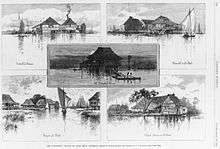
Despite the fact that there are other enclaves of Filipinos living outside this district (such as Carson,Long Beach, Glendale, Cerritos, West Covina, Panorama City, and Eagle Rock), it was named "Historic Filipinotown" since it was one of the few areas where Filipinos first settled during the early part of the 20th century and home to key Filipino organizations, Filipino churches (Filipino Christian Church, Iglesia ni Kristo, St. Columban Filipino Catholic Church, United Church of God Ministries, Praise Christian Fellowship and Congregational Christian Church), housing (Manila Terrace, Mindanao Towers, Mountain View Terrace, and Villa Ramos), and social service centers. Many Filipino American families began purchasing homes and establishing businesses in the area beginning from the 1940s, shifting away from the downtown area now known as Little Tokyo in the 1920s and later the Bunker Hill area.[2]
In a section of downtown Los Angeles now known as Little Tokyo, a thriving community known as Little Manila existed and flourished for over two decades (1920s-40s). The first significant wave of Filipino migration came in 1923, when over 2,000 arrived in California. Ten years later, over 6,000 resided in Los Angeles, most living in the downtown neighborhood bordered by San Pedro Street to the east, Sixth Street to the south, Figueroa Street to the west, and Sunset Boulevard to the North. Twelve restaurants, seven barbershops, the immigrant newspaper The Philippines Review and the Manila Portrait Studio all helped to buoy the Los Angeles Filipino diaspora. Many of the Filipino pioneers came to Los Angeles to study, while others settled as residents for employment. This community of mostly males established numerous restaurants, pool halls, cafés, employment agencies and barbershops which became the hub where Filipinos congregated, lived, socialized, organized and networked among their compatriots to find companionship, fellowship and work. One would merely drive to First and Main Streets to solicit Filipinos, either by Hollywood studios in need of ethnic-type extras for cinematic productions or many others in need of cheap labor.[3]
While gambling and taxi dance halls provided the overwhelmingly male Filipino community with distraction from their grinding labor, these activities drew condemnation from some quarters within Little Manila. Boxing, however, drew no such criticism; moreover, it brought a diverse population—sometimes divided ethnically between Ilocanos, Visayans, Tagalogs and Boholanos—together into one experience. "They didn't care if a person was Visayan, Ilocano, Boholano, Cebuano," notes Stockton's Jerry Paular. When a Filipino boxer emerged victorious, "Ilocano was embracing the Visayan and the Tagalog." In Los Angeles, Johnny Samson, one of only two Filipino boxing trainers at the time, served as chairman of the L.A. Filipino Unity Council. Boxing would prove to be one of the most influential and lasting forms of attraction among Filipinos in California. Some historians also believe that Filipinos in Los Angeles were the original wearers of zoot suits. According to Rudy Estrada, an original Zoot Suiter who was attacked while walking in downtown Los Angeles in 1944, “Chicanos didn't invent the Zoot Suit style; it was the Filipinos. Ducktail hairdos—Filipinos started that, too.”
In recent times the population of Historic Filipinotown has changed to reflect the ethnically diverse nature of Los Angeles. While the district still has a sizable Filipino population, they are the minority, overshadowed by a sizable Mexican-American and Central America]n population. Nevertheless, the area still has one of the highest concentrations of Filipino Americans in Southern California and still remains the cultural heart of Filipinos throughout Los Angeles. Of the 600,000 Filipinos that reside in the Los Angeles metropolitan area, an estimated 10,000 live within Historic Filipinotown. Nearby Chinatown also has about the same number of Chinese residents living within their own district. Though the population of Historic Filipinotown, or "Hi-Fi" (Los Angeles mayor Eric Garcetti's preferred shorthand moniker), is roughly 25 percent Filipino, it still boasts a higher ratio of Filipinos than nearby Koreatown has Koreans (15 percent) and Thai Town has Thais (less than 5 percent).
The “Historic” label was added to recognize the area as a gateway and the current place where Filipino immigrants settle, create businesses and have community-based activities. This was because the Filipino American community in Historic Filipinotown created a partnership with mayor Eric Garcetti, as a result, he maintained a staff position assigned to the Historic Filipinotown neighborhood during his tenure.[4]
By the early 1950s, Filipinos were able to buy land in the United States. In Los Angeles, many Filipino families bought their first homes in the Temple-Beverly corridor, with the growth of Filipino families in this corridor, they created Filipino-owned businesses, establishments, churches, and organizations.[5]
On October 31, 2011, Historic Filipinotown was officially recognized as one of the nation’s Preserve America Communities after years of advocacy by the Pilipino American Network and Advocacy (PANA) and other community advocates. Receiving this honor from former First Lady and Honorary Chair of the Preserve America Initiative, Michelle Obama, Historic Filipinotown is provided with strong federal support and incentives for the continued preservation of cultural and natural heritage resources. As a Preserve America Community, Historic Filipinotown is featured in the National Register Travel Itineraries and in “Teaching with Historic Places” curricular materials created by the National Park Service.
On January 28, 2012, representatives from Preserve America and the California State Historic Preservation, as well as various elected officials and community leaders, gathered at Unidad Park for “Preserving Historic Filipinotown: A Community Celebration.” In addition to the official ceremony of Historic Filipinotown’s Preserve America designation, this celebration also honored the restoration of the mural at Unidad Park, as well as the designation of Remedios “Remy” V. Geaga Square, located at the intersection of Alvarado Street and Temple Street.
Demographics
Although the enclave is named “Historic Filipinotown,” the Hispanic or Latino community comprises a majority of the population. In 2016, the population of Historic Filipinotown consisted of 4% Blacks, 8% Non-Hispanic Whites, 32% Asians, and 56% Hispanic or Latinos.
In Historic Filipinotown, the healthcare and social assistance category comprises nearly half of the total number of existing jobs. According to the 2015 Longitudinal Employer-Household Dynamics (LEHD) data, healthcare and social assistance comprise 47% of the total jobs; accommodation and food services at 10%; management at 9%; and professional, scientific, and technical at 9%.[6] These four categories compose the four largest percentage of total jobs within Historic Filipinotown. A trend that can be seen throughout the Filipino community is a tendency to work in healthcare professions. Fulfilling the demand for healthcare professionals in the U.S. many Filipino healthcare professionals immigrated to the U.S. The high number of individuals in the healthcare profession on the graph can be explained by this.
According to the 2016 5-Year American Community Survey (ACS), the poverty rate of Filipinotown is higher than Los Angeles County. The poverty rate for the Los Angeles County is 18% while the poverty rate for Historic Filipinotown is 24%.[7]

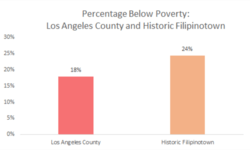

Community organizations
There are several organizations based in the Historic Filipinotown area. These include:
Pilipino American Network and Advocacy (PANA) PANA, Pilipino American Network and Advocacy, was founded to advocate for the economic and political empowermrnt of Filipinos in Los Angeles County. The organization, with the help of the Filipino community, successfully advocated for the designation of Historic Filipinotown as a Preserve America Community with the US Federal government in 2011.[8]
Search to Involve Pilipino Americans (SIPA) SIPA, Search to Involve Pilipino Americans, was founded in 1972 and helps to provide health and human services as well as helps in the economic development, arts and cultural programs for youth and families in Filipinotown and the greater Los Angeles Fil-Am community.[9]
Filipino American Services Group, Inc. (FASGI) FASGI, incorporated in 1981, is a “community based on non-profit social service agency that focuses on the health and well being of undeserved adults, particularly senior citizens…”[10]
Historic Filipinotown Neighborhood Council (HIFNC) The Historic Filipinotown Neighborhood Council (HIFINC) leads the effort for cultural, political and economic development in the district.[11]
Filipino American Community of Los Angeles, Inc. (FACLA) Originally founded as the Filipino Unity Council in 1930, the Filipino American Community of Los Angeles (FACLA) is housed in the Filipino Cultural Center located on 1740 W. Temple Street.[12]
Pilipino Workers Center (PWC) The Pilipino Workers Center aims to "secure the dignity and safety of the Pilipinx community in Southern California and build labor leaders in the domestic worker industry". They were established in 1997.[13]
There are four major annual events in Historic Filipinotown: the Historic Filipinotown Festival, the Philippine Independence Day Parade and Festival, the Larry Itliong Day Festival and the Christmas Lantern Parade and Festival.
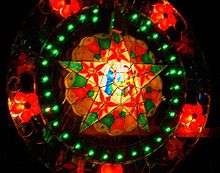
Current events
Since 2006, the Historic Filipinotown Neighborhood Council, in an attempt to ‘re-Filipinize’ the neighborhood, throws a festival and fundraising campaign.
The Pilipino Workers Center (PWC) in partnership with LA-based social enterprise Public Matters, has an event called Hidden HiFi which shines light on the neighborhood assets through different events and Jeepney tours.[14] Designated by the Department of Cultural Affairs as one of the cultural treasures of Historic Filipinotown[15], Sunday Jump is a monthly open mic series primarily held at PWC's community halls.[16]
The Filipino American Library sponsors several bus tours throughout the year that include visiting Gintong Kasaysayan, Gintong Pamana in Unidad Park.
Over 31 "polemount" Parols are installed along Temple St. coinciding with festivities in the Philippines, the longest celebration of Christmas in the world. In addition a parade of parols, or Christmas lantern are paraded during the last day of Simbang Gabi which are a series of masses in the Philippines which are held from December 16–24.
“By the early 1950s, Filipinos were able to buy land in America, and many Filipino families in Los Angeles purchased their first homes in the Temple-Beverly corridor. Filipino-owned businesses, establishments, churches, and organizations flourished in the corridor throughout the years, resulting in the community's attachment to a place. The relatively recent designation of Historic Filipinotown is representative of this attachment.[3]
Cultural landmarks
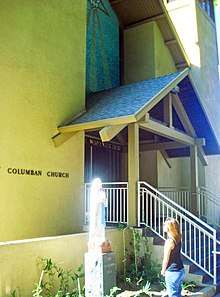
- Filipino Christian Church and St. Columban Filipino Catholic Church
On May 5, 1998, the Los Angeles City Council designated the Filipino Christian Church as Los Angeles Historic-Cultural Monument No. 651.
The Filipino (Disciples) Christian Church is the only historic cultural monument designated by the City of Los Angeles with Filipino origins, distinguished by its German Gothic Revival and Craftsman architecture. The Disciples of Christ State Board adopted the work with the Filipinos as its mission and called on Rev. and Mrs. Frank Stipp, former missionaries to the Ilocos provinces, to oversee the work. Through them and the Disciples of Christ State Board, a center was later started when the Disciples secured for the Filipino Christian Fellowship four bungalows complete with apartment facilities and a place of worship located at First Street and Bunker Hill, where the Los Angeles Music Center and Walt Disney Concert Hall stand today. It is believed that these quarters sparked the start of what is known now as Historic Filipinotown. Having been the earliest Christian church established to cater to Filipino Americans, many key organizations in the area germinated from this church, including SIPA and the Filipino American Library.
Purchased in part by funds donated by Philippines First Lady Aurora Quezon as a gift to the Filipinos in Los Angeles, the St. Columban Filipino Church on Beverly Blvd and Loma Drive has authentic church bells from the City of Antipolo, Philippines. The church sits on Crown Hill, one of the five hills that circled early downtown Los Angeles. In the 1890s, Crown Hill was the epicenter of a massive oil boom when Edward L. Doheny and Charles A. Canfield bought a lot at Colton Street and Glendale Boulevard and, in November 1892, they struck oil.


- Gintong Kasaysayan, Gintong Pamana mural
Before the area was designated as Historic Filipinotown, on June 24, 1995,[17] the nation's largest Filipino American mural, Gintong Kasaysayan, Gintong Pamana (Filipino Americans: A Glorious History, A Golden legacy), was unveiled. The mural promotes ethnic solidarity and the fight for historical inclusion of the ‘forgotten’ or ‘invisible’ Filipinos in American history.[18] For example, the mural includes Larry Itliong who challenged young Filipino American activists to organize themselves to fight for equality in the 1960s and fought alongside Cesar Chavez to lead the Delano Grape Strike groups (Kim, 1999). The mural also includes apl.de.ap, who is a hip hop performer, rapper, producer, and composer.[19]
In 1997, the City of Los Angeles Board of Cultural Affairs Commissioners awarded the mural its first ever Award of Design Excellence for public art. The mural was likewise featured in Los Angeles County Museum of Art's "Made in California: Art, Image and Identity 1900-200", the Smithsonian Institution's traveling exhibition celebrating 100 years of Filipino migration to the United States called "Singgalot (The Ties That Bind): From Colonial Subjects to Citizens" and the Smithsonian Traveling Exhibition "I Want the Wide American Earth" honoring the history and contributions of Asian and Pacific Islanders in the United States.[20][21] The mural was painted by then 22-year-old artist Eliseo Art Silva[22] while a junior attending Otis College of Art and Design.[23] According to the artist, "...the mural encapsulates 5,000 years of Filipino and Filipino American history; the design is divided into two parts: the first is historical (represented by the outline of a fish at sea), leading up to the awakening of Filipino national and political consciousness; the second part is dominated by a huge bird with significant Filipino-Americans on its wings, the farm workers on the bottom left and the youth and community on the right."[24]
- Unidad Park and Community Garden
The mural originally faced a large community garden called the Candy Chuateco Community Garden. Sponsored by Search to Involve Pilipino Americans, The land was purchased by the City of Los Angeles and converted into the Unidad Park through the Los Angeles Neighborhood Land Trust (LANLT).[25] Unidad Park's design was conceptualized by leaders and stakeholders of the Filipino community and based largely from submitted renderings by the mural artist Eliseo Silva, which includes the Philippine Bontoc/Kankana-ey communal gathering place, park features and a community garden referencing the Rice Terraces of the Philippine Cordilleras, a UNESCO World Heritage Site, as well as an entrance walkway based on a design by Filipino American Pedro Flores.[26] The park is a destination for the neighborhood with its Dap-ay[27] used by students and the sandbox inside this space used by toddlers, the interactive play area, community garden as well as onsite barbecue grills with matching tables and benches for family gatherings and parties, enhanced by a covered tent to protect park users from the sun and rain.[28]
- Hi-Fi signage, street medallions (banners) and crosswalks
In 2007, Caltrans and the Historic Filipinotown Neighborhood Council (HIFINC), with financial support from the community, installed Historic Filipinotwn signage along the US 101 Freeway directing traffic to the area with the Alvarado and Glendale Boulevard exits. The crosswalks in Filipinotown have been decorated with traditional Filipino basket-weaving patterns designed by Edwin Frederizo, who also designed the district's street banners.[29] "My design for the permanent art display conveys a message of peace, unity, and harmony amongst the community of Historic Filipinotown. The uniqueness of having Filipino American residents and businesses embedded within a variety of cultures allows for a very rich and conceptual visual art display. The Filipino American culture is influenced by several other cultures (Latino, Chinese and African American) and is fused into a very unique style all its own."[30]
In 2007, Caltrans and the Historic Filipinotown Neighborhood Council (HIFINC), with financial support from the community, installed Historic Filipinotown signage along the US 101 Freeway. The Hi-Fi sign directs traffic to the area with the Alvarado and Glendale Boulevard exits and marks the western gateway into the enclave. In addition, there are street signs that indicate the boundaries of Historic Filipinotown above the normal street signs such as the sign located on the northern border on Temple Street.

Along the streets of Historic FilipinoTown are lamp posts adorned with Filipino cultural medallions. These medallions decorate the tops of lamp posts with different symbols. Roel Punzalan is the artist who designed the streetlight art. His vision for the project was to tie the Filipino values of “kapwa,” “lakbay,” and “kapayapaan” to the unique interaction of Filipino culture and Historic FilipinoTown.[31] The streetlight art served both as an educational opportunity to share Filipino culture and history and as a way to improve pedestrian safety. Streetlights were placed at 17 different intersections, and about 54 lamp posts were adorned with Punzalan’s art.[32]
The Filipino cultural values can be defined as followed: “kapwa” is “shared humanity or togetherness,” “lakbay” is “journey,” and “kapayapaan” is “peace”.[33] These are the descriptions for each streetlight art:
- “Kapwa: Shared Humanity - ALL HANDS IN. The Filipino Sun, a symbol of unity, is created by stacking hands in a team huddle, a gesture of unity.”
- “Lakbay: Journey - BUILD BRIDGES. Two figures holding hands to form a bridge symbolizes both the journey to America and the relationships that are created among the various people after they arrive.”
- “Kapayapaan: Peace - EMBRACE PEACE. The parol, a star-shaped lantern symbolizing the Filipino Christmas, is created by interlocking figures in a group hug as a reminder of peace throughout the year.”
Punzalan explained that the streetlights highlight the importance of humanity in the Filipino culture and that the people are essential for the culture to last through the challenges and passage of time.
.png)
- Filipino American WWII Veterans Memorial
In November 2006, Eric Garcetti, then-president of the Los Angeles City Council, joined Filipino veterans from around the country in unveiling the first monument dedicated to the 250,000 Filipino and 7,000 Filipino American soldiers who fought for the United States in World War II. The monument, located in Lake Street Park in the heart of Historic Filipinotown, consists of five slabs of polished black granite and commemorates the history of the Filipino veterans, from WWII to immigration to their subsequent fight for equality. It was designed by artist Cheri Gaulke and the project was led by Joe Bernardo, a former staffer of Eric Garcetti.[34] Inscribed in the front of the memorial is the quote, “Bataan was not our last battlefield. We are still fighting for equity,” by Faustino “Peping” Baclig. Baclig, a survivor of the Bataan death march and longtime leader of the movement to gain financial and medical benefits for the veterans comments on the longstanding battle that the Filipino community would face to gain recognition and equality in the country.[35]
- Iglesia ni Cristo (INC) Los Angeles Locale Congregation
Located at 141 North Union Avenue, the Iglesia ni Cristo is a Filipino Non-Trinitarian Sect founded in Manila, Philippines in 1914. The group started their overseas mission in 1968. The Los Angeles congregation was one of the earliest locales to be established in the United States after Ewa Beach in Hawaii and San Francisco."Los Angeles's Historic Filipinotown". It is also one of a few sites in the neighborhood with Filipino vernacular architecture.[36] The facade and spires of this chapel were inspired by the Filipino head gear known as salakot.[37]
- Filipino Designs and Vernacular Architecture in HIFI
Clustered within the vicinity of Beverly-Union are the oldest Filipino Churches of Los Angeles: The Filipino Christian Church (FCC), St. Columban Filipino Catholic Church and the Iglesia Ni Cristo (INC) Kapilya (chapel). These sites are legacies of Filipino Americans who arrived prior to the passage of the Immigration and Nationality Act of 1965 which triggered a population boom, attracting skilled labor to the United States.[38] FCC and St. Columban both have entrances that include stylized "Naga/Bakunawa" rooftop end-beam motifs typical of "Bahay ng Maginoo" precolonial wooden longhouses platformed on stilts built for the "Maginoo" (Nobility) class of pre-Hispanic Philippines.[39] The INC "Kapilya" (Chapel/Cathedral) on Union Avenue has a facade and spires inspired by the Filipino headgear known as salakot.[37] Also within this enclave is Unidad Park which combines the Cordillera Dap-ay (learning circle/gathering place), the entrance walkway shaped like a Yo-yo, the terraced community garden honoring the Rice Terraces of the Philippines and with the building-sized Filipino mural serving as a backdrop to these Filipino design elements.[40]
Further east on Glendale Blvd is Larry Itliong Village Apartments, which is also the main headquarters of the Pilipino Worker's Center. This site combines three Filipino design elements: the "piloti" which was first introduced to this country during the 18th Century by Filipino settlers of St. Malo and Manila Village who built houses made of wood and platformed on stilts; the four inter-woven red bars above the main entrance which pays homage to Filipino baskets, ethnic weaving, the commoner's house (bahay kubo which was essentially built like a basket), and the bamboo dance known as "Tinikling"; with the sun with eight rays of the Philippine flag completing the Filipino branding of the site.[41] The piloti can also be detected at Luzon Plaza Mall along Temple Street, which was named after the largest island of the Philippines. The Spanish-Era Bahay na Bato (House of Stone), which evolved from the precolonial wooden palacial long houses of Filipino Nobility known as "Bahay ng Maginoo", is showcased at the Manila Terrace Apartments along Temple St. The commoner's house called "Bahay Kubo" (nipa hut) can be seen at the Kubo Restaurant at the Corner of Temple St. and Parkview Street. Its teal-green bamboo-tiled roof design elements inspired the proposed design of the projected Eastern Gateway of Historic Filipinotown[42].[43]
The "Bahay Kubo" vernacular architecture is also evident in the design of the Filipino Cultural Center owned by the Filipino American Community of Los Angeles (FACLA) which proudly extols the Philippine Flag 24/7 in front of its building along Temple Street.[44] Also along Temple Street are 54 bus stops with Filipino lanterns known as Parol and the Philippine Sun of the national flag integrated into the lamp posts.[45] The Western Gateway Marker on the western boundary of the neighborhood integrates the "calado" embroidery with floral and vine motif of the "Barong Tagalog" and "Maria Clara" national attire of Filipinos on the facade; as well as the "Bakunawa" (Filipino Dragon) (which are carved into both sides of the marker) serving as guardians of the ancient kingdoms of the Philippines in the past, and the HIFI neighborhood of Los Angeles in the present.[46]
In conjunction with the four-month Christmas Season in the Philippines, some of the 10,000 Filipino residents of HIFI display the Parol (Filipino lanterns) in front of their windows or homes as early as September (though most do so after Thanksgiving Day) all the way until the first Sunday of January the following year.[47]
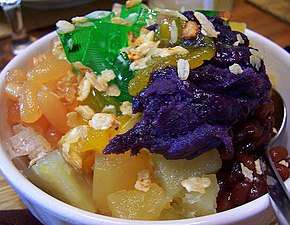

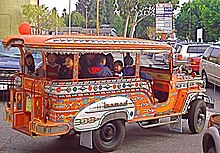
Education
Like the rest of the city of Los Angeles, the area is within the Los Angeles Unified School District.
Samahang Pilipino Advancing Community Empowerment (SPACE)
Samahang Pilipino Advancing Community Empowerment (SPACE) is an access project created in 2000 by Samahang Pilipino at UCLA, the official student organization for the Pilipino and Pilipino American communities at UCLA. SPACE addresses and alleviate the barriers to higher education for at-risk, historically underrepresented, underserved high school and community college students in the Los Angeles area. Through peer tutoring, peer advising. student workshops, parent workshops, and field trips, SPACE promotes “academic success, personal well-being, community engagement, and the formulation of solid post-secondary plans”.[48]
Until 2017, SPACE was partnered with Belmont High School, which is located in Historic Filipinotown.
In 2015, SPACE hosted Philipine Youth Empowerment Day, an event that featured workshops focused on Filipino-American history, identity and representation in the media.[49]
See also
- Los Angeles, California
- Filipino American
- Little Manila
- History of Filipino Americans
References
- Khouri, Andrew (December 3, 2014) "Northern edge of Westlake finally getting developers' attention" Los Angeles Times
- Shyong, Frank (2020-01-06). "Here's how HiFi, or Historic Filipinotown, got its name". Los Angeles Times. Retrieved 2020-01-06.
- Montoya, Carina. Los Angeles' Historic Filipinotown. Arcadia Publishing. Retrieved 2014-08-18.
- Villanueva, G. (2015) Filipinos for Garcetti: Ethnic political organizing in Los Angeles and Asian American civic engagement in cities. Asian American Policy Review, 26, 10-19. * Retrieved February 12, 2018, from https://ecommons.luc.edu/cgi/viewcontent.cgi?referer=https://www.google.com/&httpsredir=1&article=1021&context=communication_facpubs
- Montoya, C.M. (2009). Images of America: Los Angeles’s Historic Filipinotown. Charleston, South Carolina: Arcadia Publishing. Retrieved March 01, 2018, from https://books.google.com/books?id=dQzdqdB3AIsC&printsec=frontcover#v=onepage&q&f=false
- "Longitudinal Employer-Household Dynamics". Retrieved February 28, 2018.
- "2016 5-Year American Community Survey". Retrieved February 28, 2018.
- "First Lady Designates Historic Filipinotown a Preserve America Community | Advisory Council on Historic Preservation". www.achp.gov.
- "SIPA". www.sipacares.org.
- "FASGI".
- "Historic Filipinotown Neighborhood Council". www.facebook.com.
- "Filipino Cultural Center Los Angeles". www.facebook.com.
- "Homepage". www.pwcsc.org. Retrieved 2020-07-31.
- "Chicharron Chronicles". izi.TRAVEL.
- "Cultural treasures in your own neighborhood? They're all over L.A." USC News.
- "Sunday Jump' brings performance art, open mic to Historic Filipinotown LA". USA Inquirer. 5 October 2017. Retrieved 5 October 2017.
- "TEMPLE-BEAUDRY : Mural to Spotlight Filipino Americans". LA Times. February 12, 1995.
- Baluyut, P. R. S. (1998) A glorious history, A golden legacy: The making of a Filipino American identity and community. Amerasia Journal, 24(1), 193-216. Retrieved March 09, 2018, from Baluyut, Pearlie Rose S. (1998). "A Glorious History, A Golden Legacy: The Making of a Filipino American Identity and Community". Amerasia Journal. Informa UK Limited. 24 (3): 192–217. doi:10.17953/amer.24.3.c6gw757334m16p2p. ISSN 0044-7471.
- Devitt, R. (2008). Lost in translation: Filipino diaspora(s), postcolonial hip hop, and the problems of keeping it real for the “contentless” Black Eyed Peas. Asian Music, 39(1). 108-134. Retrieved March 01, 2018, from
- "Smithsonian Institution Traveling Exhibition Service". www.sites.si.edu. Smithsonian Institution. Archived from the original on 2015-04-01. Retrieved 2015-05-25.
- "Exhibition/Event Calendar- New Americans Museum". New Americans Museum, San Diego. Archived from the original on 2009-06-18.
- Lee, Jay. "Eliseo Art Silva Website". godaddy.com. Retrieved October 2003. Check date values in:
|accessdate=(help) - LOS ANGELES PHOTO GALLERY, Martin. "Filipino-American heritage mural at the Beverly Union Park".
- Dunitz, Robin. "ELISEO ART SILVA: PHILIPINO AMERICANS: A GLORIOUS HISTORY, A GOLDEN LEGACY". MCLA.
- "Green Season: Beverly Union Park". lacityorgcd13. Retrieved September 17, 2007.
- Montoya, Carina Monica (2009). Los Angeles's Historic Filipinotown. Arcadia Publishing. p. 96. ISBN 978-0-7385-6954-3.
- Jenks, Albert Ernest. "Dap-Ay and Stones with excerpt from the ethnographic study of the early Bontoc Igorots in 1905". Dap-ay is the usual venue for community gatherings, be it informal or ceremonial. But most importantly, it is the place where peace pact (pechen/peden) between warring tribes is being arranged or settled. From the study of Michael Brett in 1987, “Pechen“ is defined as “a ritualized oral contract between two villages with the purpose of establishing peaceful relations… a contract held in safekeeping by a particular ator of each village“.
- Angeleno, Militant. "Saturday in the Parks". Blogger. Retrieved September 15, 2007.
- "Crosswalks in Hi-Fi". lacityorgcd13. Retrieved November 1, 2005.
- "Banners for Hi Fi". Council District 13 enews. Archived from the original on 2011-07-20. Retrieved 2011-04-25.
- "Hi-Fi Lights LA City".
- Mardo, P. (2017, January 24). Historic Filipinotown's new lights illuminate L.A.'s vibrant Filipino community. LA Weekly. Retrieved March 01, 2018, from
- Mardo, P. (2017, January 24). Historic Filipinotown's new lights illuminate L.A.'s vibrant Ilipino-community-7468250.
- Garcetti unveils nation's first Filipino veterans memorial (PDF), City of Los Angeles, November 13, 2006, archived from the original (PDF) on September 26, 2007, retrieved 2007-12-11
- Kang, K. Connie. (2006) New Monument Honors Filipino American Vets. Los Angeles Times. Retrieved March 01, 2018, from
- "Center for the Study of Political Graphics". collection-politicalgraphics.org.
- "Architecture". October 29, 2013.
- "Center for the Study of Political Graphics". collection-politicalgraphics.org.
- Baluyot, Michael Sherwin. "Bahay na Bato, a Symbol of the Affluent Westernized Filipino" – via www.academia.edu. Cite journal requires
|journal=(help) - Constante, Agnes (November 8, 2016). "A Los Angeles park that honors Filipino American legacy". INQUIRER.net.
- "Real estate portfolio" (PDF). www.ltsc.org. Retrieved 2020-07-31.
- "Gateway landmark to be erected in Los Angeles' Historic Filipinotown later this year —". June 13, 2020.
- "Hometown Highlights: Discovering the Historically Filipino in HiFi, LA". BakitWhy.
- "Filipino Cultural Center Los Angeles, 1740 W. Temple Street, Los Angeles, CA (2020)". www.eventyas.com.
- Radio, Southern California Public (October 27, 2016). "Historic Filipinotown brightens up with 54 new light fixtures". Southern California Public Radio.
- "From Filipino Object to American Subject: The Struggle for Filipino American Art". FilAm ARTS.
- Brown, Sarah. "The Philippines shows the world how to celebrate Christmas". CNN.
- "Samahang Pilipino Advancing Community Empowerment". Samahang Pilipino. Retrieved March 13, 2018.
- "Philipin* Youth Empowerment Day engages students in cultural dialogue". Retrieved October 25, 2018.
Further reading
- "Culture and Health Among Filipinosand Filipino-Americans in Central Los Angeles" (PDF). California Endowment. Semics, LLC. November 2007. Archived from the original (PDF) on 2014-11-27.
- Borah, Eloisa. "Carlos Bulosan`s Los Angeles" (PDF).
External links
- History of Historic Filipinotown
- History of Filipinos in Los Angeles
- St. Columban Filipino Catholic Church
